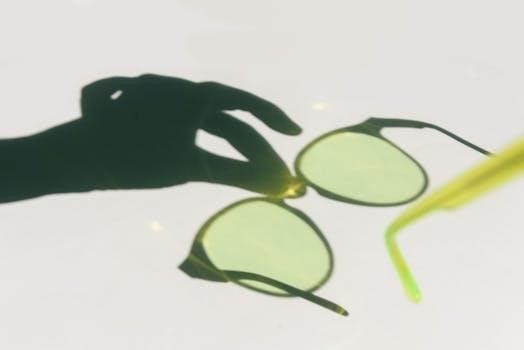Overview of “Interaction of Color” by Josef Albers
Josef Albers’s “Interaction of Color” is a foundational text in art education. It explores color theory through experimental exercises. The book serves as a handbook for artists and educators alike, offering a unique perspective on color perception.
Significance in Art Education
Josef Albers’s “Interaction of Color” holds immense significance in art education, acting as a cornerstone for understanding color theory. It moves beyond traditional approaches by emphasizing experiential learning through hands-on exercises. Albers’s method encourages students to observe and analyze color relationships, fostering a deeper comprehension of how colors interact and influence each other. This approach is invaluable for artists, designers, and educators alike, providing a framework for exploring the subjective nature of color perception. The book’s influence extends to various disciplines, shaping how color is taught and applied in contemporary practice. It remains a masterwork in art education.

Key Concepts of Color Theory
The book delves into core concepts such as color relativity and interaction. It explores how context affects color perception. Albers also covers color subtraction and addition principles.
Relativity of Color Perception
Albers emphasizes that color is rarely perceived in isolation, but rather in relation to its surroundings. He demonstrates how the same color can appear different depending on its neighboring colors. This concept of color relativity challenges the idea of fixed color identity. The book explores how our visual memory and context influence our perception. Through experimental exercises, Albers teaches the reader to see color as a dynamic and fluid phenomenon. He stresses that color’s appearance can be significantly altered by its surroundings. This concept is central to understanding how artists manipulate color. This is essential for any artist. The book makes this a foundational concept.
Color Interaction and Context
The book highlights how colors interact with each other and how context drastically alters our perception. It is not just about the color itself, but the colors that are surrounding it. Albers delves into how one color can appear as two different colors depending on the background. This is a key concept for any artist. Through visual examples, he demonstrates how colors can change and shift in appearance. He explores the effects of light intensity and lightness on color perception. This teaches a deeper understanding of visual manipulation. He uses the example of how colors can appear to reverse their grounds. The context of the color greatly influences its perceived appearance.
Color Subtraction and Addition
Albers explores color subtraction and addition, showing how colors mix and create new hues. He demonstrates that one color can play many roles. This concept is crucial for artists to understand the complexities of color. Albers reveals the possibility of making two different colors look the same through subtraction of color. This highlights how we perceive color rather than how it truly is. The book provides exercises that help the reader understand this concept. He uses paper in his exercises rather than paint. This helps to isolate the concept for better learning. Understanding these principles enhances one’s ability to manipulate color in their work.

Content and Structure of the Book
The book documents an experimental approach to studying and teaching color. It uses visual examples and exercises to demonstrate complex principles. “Interaction of Color” is structured for hands-on learning.
Experimental Approach to Studying Color
Albers’s methodology in “Interaction of Color” emphasizes a hands-on, trial-and-error approach to understanding color. He moves away from traditional, theoretical discussions, advocating for direct visual experience. The book encourages readers to actively engage with color through exercises. This involves manipulating colored papers to observe how colors interact and influence each other. Albers believes that true understanding of color comes from this experiential learning. This approach allows for personal discovery of color principles. The aim of the study is to develop an eye for color through experience. This method is designed to challenge preconceived notions. It helps to form a more nuanced understanding of color perception.
Exercises and Visual Examples
“Interaction of Color” is abundant with practical exercises that illustrate key color principles. Albers employs colored paper rather than paint, emphasizing the direct manipulation of color. These exercises often involve juxtaposing different hues to observe their visual interactions. The book provides numerous visual examples, demonstrating how colors can appear different based on their context. These examples reveal the relativity of color perception. The exercises are designed to challenge the viewer’s understanding of color. They encourage active participation in learning color theory. The visual plates accompany the text. They help clarify the principles. This hands-on approach makes the concepts accessible. It also allows for a deeper engagement with the material.
Original Edition and Selected Plates
The original edition of “Interaction of Color” features a collection of meticulously chosen plates. These plates visually demonstrate Albers’s color theories. The book’s structure combines text with visual examples, creating a cohesive learning experience. The selected plates are not merely illustrations, but integral components of the theoretical framework. They showcase how colors interact and influence each other. The original text is paired with these plates, providing a direct link between theory and visual practice. The plates serve as a record of Albers’s experimental approach. This allows readers to engage with his discoveries firsthand. The original edition emphasizes the importance of visual observation in understanding color. It forms the basis for subsequent editions.
Editions and Availability
The book has multiple editions, including a 50th-anniversary version. It is available in PDF format for download online. Various platforms offer access to both the original and revised texts.
50th Anniversary Edition
The 50th Anniversary Edition of “Interaction of Color” expands on the original, featuring a broader selection of color studies. This edition is highly regarded as a masterwork in art education, conceived as a handbook for artists, instructors, and students. It presents Albers’ unique explanation of complex color theory. This version includes the original text, plates, and commentaries, providing a comprehensive study of Albers’s work. It remains an indispensable blueprint for understanding color interactions. The edition includes digital access, allowing users to view and interact with plates and search the content for specific information. It’s available for download in PDF format from various online sources.
PDF Download Options
Numerous platforms offer “Interaction of Color” by Josef Albers for PDF download, catering to various needs. Many websites provide the 50th Anniversary Edition in PDF format, making it readily accessible. Some sites offer free downloads, while others may require a purchase. Formats available often include single-page processed JP2 ZIP files. Users are advised to ensure they download from trusted sources to avoid viruses. Several online libraries provide PDF versions, allowing users to read or download the book. The ability to download a PDF enables offline access. This allows for easy reference and study of Albers’ influential color theory. Users can find the book on various online platforms.

Influence and Legacy
Albers’ work has profoundly impacted art and design education. His teachings continue to inspire contemporary artists. The book remains a vital resource for understanding color theory and practice.
Impact on Art and Design Education
Josef Albers’ “Interaction of Color” has had a monumental impact on art and design education, shifting the focus towards experiential learning. His experimental approach, emphasizing the relativity of color perception, became a cornerstone of modern art pedagogy. The book’s structure, combining text with visual exercises, provides a unique learning experience for students and educators alike. Albers’ influence is evident in countless art programs worldwide, where his method of color study is still regarded as essential for understanding the complexities of visual perception. This influence extends to a variety of disciplines, shaping how color is taught and applied in graphic design, painting, and beyond, making it a truly transformative work.
Application in Contemporary Practice
The principles outlined in Josef Albers’ “Interaction of Color” continue to be highly relevant in contemporary art and design practices. Artists and designers use Albers’s concepts to explore color relationships and to achieve specific effects in their work. The focus on the context of colors and their relativity remains a crucial aspect of visual communication. These concepts are applied in diverse fields, from digital art and web design to fashion and interior decoration. The understanding of how colors interact and influence one another helps professionals make informed decisions and achieve desired visual outcomes. Furthermore, his minimalist approach to color studies provides a valuable framework for visual experimentation and creative exploration in modern design.

Resources and Further Study
Online platforms and libraries offer access to the text and related materials. Digital versions, including PDFs, are readily available for deeper exploration. These resources support continued learning.
Online Platforms and Libraries
Numerous online platforms and digital libraries provide access to Josef Albers’s “Interaction of Color,” often in PDF format. These resources include large repositories like Z-Library, which offers the 50th Anniversary Edition for download. Academic databases and university library websites may also host the text. Additionally, platforms like PDFcoffee.com and Libgen.lc provide free downloads of the book. The Internet Archive contains digitized versions of the original edition. These digital avenues make Albers’s work highly accessible for students, artists, and researchers, offering convenient ways to engage with his influential color theories and experimental approach. Many sites also feature related articles and discussions.
Related Teaching Materials and Courses
Various teaching materials and courses build upon Josef Albers’s “Interaction of Color.” Educators like Dick Nelson, who studied with Albers, offer courses extending his teachings. Handouts and exercises based on the book are available online, often including practical color studies and experiments. University art programs incorporate Albers’s principles, emphasizing experiential learning and visual perception. Some platforms offer supplementary videos and interactive tools to enhance learning. These resources provide diverse ways to engage with Albers’s concepts, from structured courses to self-directed studies, fostering a deeper understanding of color interactions. Additionally, many educators have created resources based on his unique teaching methods.
